by Jan Dunn, MS
Aloha to All!
In this article, the first of a two-parter, I’d like to share a foot warm-up that comes from the Franklin Method. I learned this many years ago, from Eric Franklin, and it has been a part of my daily warm-up ever since. I have taught it to dancers (and non-dancers!) in many workshops / classes, such as for the national touring company of “A Chorus Line” – and the response has always been….”wow, I love this – thank you for teaching it to us!” I thought that since 4dancers has been highlighting feet this month, I would do an article for you describing this sequence.
This is most beneficial done before you do a class / rehearsal / performance, or even first thing in the morning when you get up. It does a lot more than just warm-up the feet, as I hope you will see as you do it along with me…
The Preparation
Before starting, take a quiet moment to “tune in” to how your body feels, especially your feet. Just stand comfortably, weight on both feet, and notice. There is no right / wrong, good / bad — it’s just a moment to see how your body is feeling overall, and your feet as well. (Think of it as a “pre-test”!)
The Exercise
1 – Massage: take just one Franklin Ball (I will discuss the balls at the end of this article), and put one foot on it. Gently roll your foot back and forth on the ball, giving the sole of your foot a nice massage. How much pressure you put on the ball is up to you, and how long you do it is also individual — your body will tell you “OK, that’s enough”. It should feel good — no pain or discomfort, please!
2 – Forefoot Rotation – Put your forefoot on the ball, heel braced on the ground (heel stays on the ground throughout) – inwardly then outwardly rotate your foot, reaching first the little toe / then the big toe down towards the ground. Your knee / hip will move with the foot — only go as far as comfortable in each direction. I usually do about 5-6 on each side. With this movement, you are getting lots of movement going in the various joints in the foot (all 33 of them!), as well as the ankle / knee / hip.
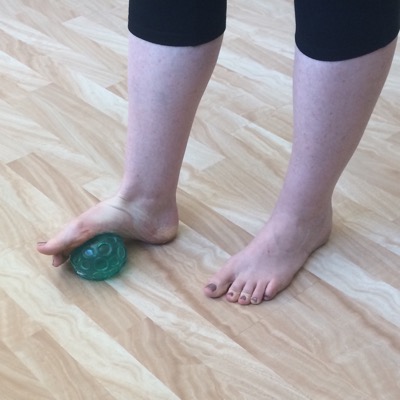

3 – Vary the inward / outward foot rolling so that now the toes are coming up and away from the floor – I like to imagine that the floor is hot, and I have to reach my big toe / little toe up to the ceiling to get away from it. So it’s still an inward / outward rotation, but is different from the toes down version.
4- Point Flex: With straight knee, ball under the arch, do a point flex about 5-6 times…so this is ankle joint planter-flexion (point) and dorsiflexion (flex), in anatomical terms.
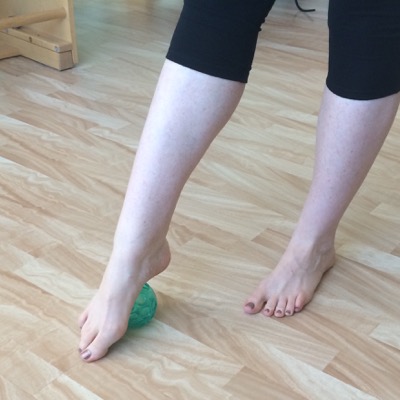
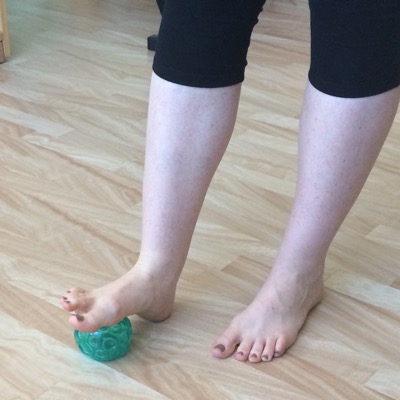
5 – Toe scrunch: With forefoot still on the ball, heel braced on floor, give the ball a good “hug” with all the toes. You may know “towel scrunch”, a classic PT exercise to strengthen the feet, where you scrunch up a towel under your toes….think of this as the same thing, only this is a “ball scrunch”.
6 – Heel rotation: Bring the ball closer to you and this time brace your toes on the floor, heel on the ball. Rotate your heel inward and outward — again letting your knee / hip go along as comfortable, 5-6 times.
7 – Step Up: Put the ball directly in the center of the foot, under the arch, and step up on it briefly, taking the other foot off the floor…i.e, you’re trying to balance on the ball for just a second, no toes or heels on the floor. Repeat 6 or 7 times (or 8 if you want). Look straight ahead — looking down even slightly will affect your overall body alignment and balance.
8 – Take the ball away and stand on both feet. Does the foot you just played with feel any different? How? Describe to yourself (or a friend, if you’re doing it with someone) how it may feel different from the other foot, or from when you did your “tune in” at the beginning.
One of the things we always do in Franklin work, is notice R-L differences after doing something — because only then can you figure out if what you are doing is beneficial or not! You are giving yourself feedback on whether or not this worked for you, and how it worked / what it affected.
The Feedback
Try a few R-L tests to see if the side you played with feels any different:
- Try a balance first on the one foot, then the other — is there a difference? Again, describe that difference to either yourself or your partner.
- If on a good floor, try a small jump on that foot — is there any difference?
- Try a small battement / hamstring kick on each leg — is there any difference in the leg you just played with? What is the difference, if there is one….?
- Try the arms / shoulders — first take one up overhead, and then the other — is there a difference? In the accompanying photo, can you guess which arm is on the same side as the foot I played with?
The Results
After this exercise, most people will find a significant difference between the two sides, with more flexibility / feeling of warm-up on the side of the foot they first used. This is because with that simple foot sequence, we have warmed things up all the way through the connected sections of our body, along “the kinetic chain” – i.e., the relationship and connections between your nerves, muscles, and bones. We have more nerve endings per square centimeter in the bottom of our foot than anywhere else in our body (over 200,000!) and they connect to everything — so we have used that to our advantage in this exercise.
Now — you should probably do the other side, yes? Yes!
When you have done both feet, again compare and notice how it feels, do your testing (balance / jump / hamstring / arm if you like) — and hopefully you will feel more balanced and warmed up on both sides!
There is a two-footed version of this, which is a terrific challenge for balance and torso stability…that will be coming in Part Two!
This sequence comes directly from the Franklin work, as I mentioned at the beginning. Eric Franklin developed the balls that are used in the photos, to specifically address the muscoloskeletal and CNS (Central Nervous System) in the most beneficial ways…you can use other balls, if you don’t have any, but if you can get FM balls, I would recommend it. I would not recommend using a tennis ball — they are too hard.
Franklin balls are available online through Amazon, from OPTP.com (a physical therapy supply house), and also from Balanced Body, the Pilates equipment company. Franklin has also published a short booklet describing this ball footwork, and others, entitled Happy Feet dynamic base, effortless posture— also available from Amazon, and OPTP.com.
So — have fun playing with this sequence — you may well find that it becomes part of your daily warm-up routine!
My gratitude to Sarah Carrasco, a former Broadway dancer and owner of Sarah D. Pilates Kauai, for her gracious help in taking the accompanying photos.
(See part 2 of this exercise series here.)

Editor Jan Dunn is a dance medicine specialist currently based on the island of Kauai, Hawaii, where she is owner of Pilates Plus Kauai Wellness Center and co-founder of Kauai Dance Medicine. She is also a Pilates rehabilitation specialist and Franklin Educator. A lifelong dancer / choreographer, she spent many years as university dance faculty, most recently as Adjunct Faculty, University of Colorado Dept. of Theatre and Dance. Her 28 year background in dance medicine includes 23 years with the International Association of Dance Medicine and Science (IADMS) – as Board member / President / Executive Director – founding Denver Dance Medicine Associates, and establishing two university Dance Wellness Programs
Jan served as organizer and Co-Chair, International Dance Medicine Conference, Taiwan 2004, and was founding chair of the National Dance Association’s (USA) Committee on Dance Science and Medicine, 1989-1993. She originated The Dance Medicine/Science Resource Guide; and was co-founder of the Journal of Dance Medicine & Science. She has taught dance medicine, Pilates, and Franklin workshops for medical / dance and academic institutions in the USA / Europe / Middle East / and Asia, authored numerous articles in the field, and presented at many national and international conferences.
Ms. Dunn writes about dance wellness for 4dancers and also brings in voices from the dance wellness/dance medicine field to share their expertise with readers.





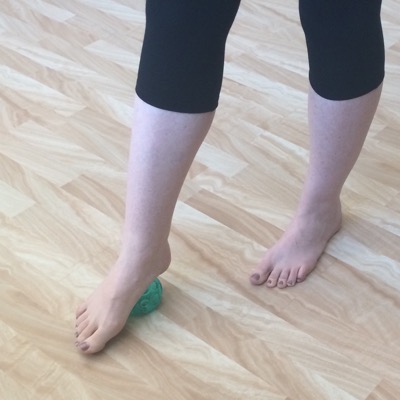



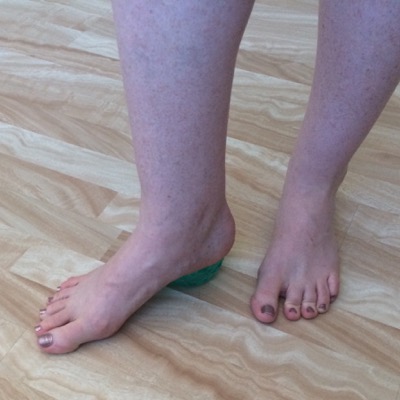
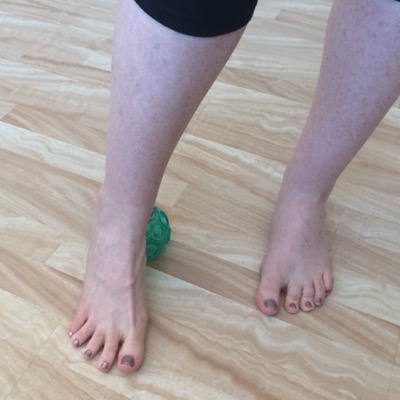
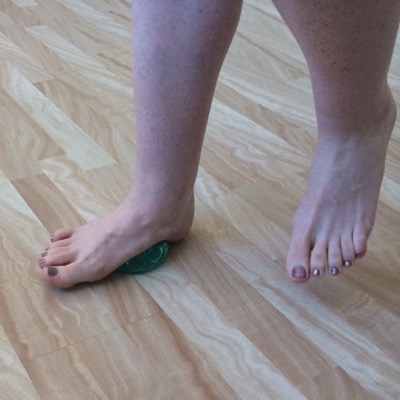


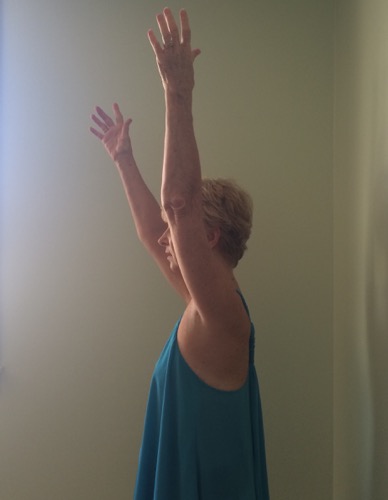
… nice training, thx for publishing!
Thanks for commenting Tryscha!